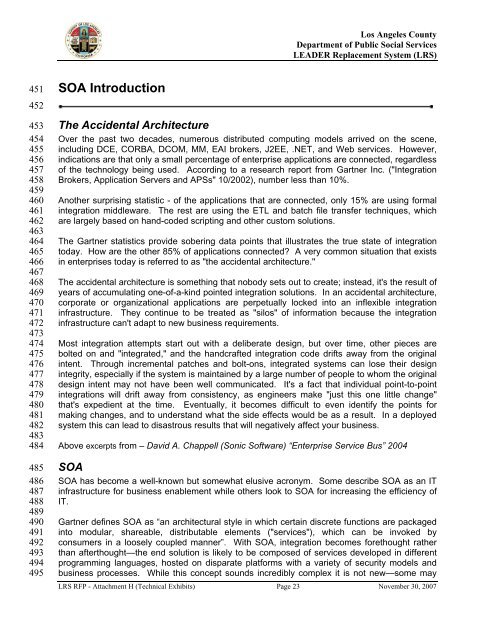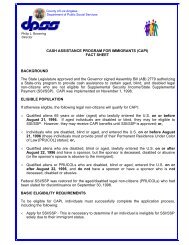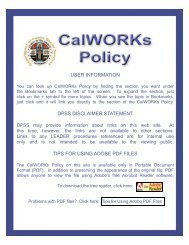leader replacement system - Department of Public Social Services ...
leader replacement system - Department of Public Social Services ...
leader replacement system - Department of Public Social Services ...
Create successful ePaper yourself
Turn your PDF publications into a flip-book with our unique Google optimized e-Paper software.
Los Angeles County<br />
<strong>Department</strong> <strong>of</strong> <strong>Public</strong> <strong>Social</strong> <strong>Services</strong><br />
LEADER Replacement System (LRS)<br />
451<br />
452<br />
453<br />
454<br />
455<br />
456<br />
457<br />
458<br />
459<br />
460<br />
461<br />
462<br />
463<br />
464<br />
465<br />
466<br />
467<br />
468<br />
469<br />
470<br />
471<br />
472<br />
473<br />
474<br />
475<br />
476<br />
477<br />
478<br />
479<br />
480<br />
481<br />
482<br />
483<br />
484<br />
485<br />
486<br />
487<br />
488<br />
489<br />
490<br />
491<br />
492<br />
493<br />
494<br />
495<br />
SOA Introduction<br />
The Accidental Architecture<br />
Over the past two decades, numerous distributed computing models arrived on the scene,<br />
including DCE, CORBA, DCOM, MM, EAI brokers, J2EE, .NET, and Web services. However,<br />
indications are that only a small percentage <strong>of</strong> enterprise applications are connected, regardless<br />
<strong>of</strong> the technology being used. According to a research report from Gartner Inc. ("Integration<br />
Brokers, Application Servers and APSs" 10/2002), number less than 10%.<br />
Another surprising statistic - <strong>of</strong> the applications that are connected, only 15% are using formal<br />
integration middleware. The rest are using the ETL and batch file transfer techniques, which<br />
are largely based on hand-coded scripting and other custom solutions.<br />
The Gartner statistics provide sobering data points that illustrates the true state <strong>of</strong> integration<br />
today. How are the other 85% <strong>of</strong> applications connected? A very common situation that exists<br />
in enterprises today is referred to as "the accidental architecture."<br />
The accidental architecture is something that nobody sets out to create; instead, it's the result <strong>of</strong><br />
years <strong>of</strong> accumulating one-<strong>of</strong>-a-kind pointed integration solutions. In an accidental architecture,<br />
corporate or organizational applications are perpetually locked into an inflexible integration<br />
infrastructure. They continue to be treated as "silos" <strong>of</strong> information because the integration<br />
infrastructure can't adapt to new business requirements.<br />
Most integration attempts start out with a deliberate design, but over time, other pieces are<br />
bolted on and "integrated," and the handcrafted integration code drifts away from the original<br />
intent. Through incremental patches and bolt-ons, integrated <strong>system</strong>s can lose their design<br />
integrity, especially if the <strong>system</strong> is maintained by a large number <strong>of</strong> people to whom the original<br />
design intent may not have been well communicated. It's a fact that individual point-to-point<br />
integrations will drift away from consistency, as engineers make "just this one little change"<br />
that's expedient at the time. Eventually, it becomes difficult to even identify the points for<br />
making changes, and to understand what the side effects would be as a result. In a deployed<br />
<strong>system</strong> this can lead to disastrous results that will negatively affect your business.<br />
Above excerpts from – David A. Chappell (Sonic S<strong>of</strong>tware) “Enterprise Service Bus” 2004<br />
SOA<br />
SOA has become a well-known but somewhat elusive acronym. Some describe SOA as an IT<br />
infrastructure for business enablement while others look to SOA for increasing the efficiency <strong>of</strong><br />
IT.<br />
Gartner defines SOA as “an architectural style in which certain discrete functions are packaged<br />
into modular, shareable, distributable elements ("services"), which can be invoked by<br />
consumers in a loosely coupled manner”. With SOA, integration becomes forethought rather<br />
than afterthought—the end solution is likely to be composed <strong>of</strong> services developed in different<br />
programming languages, hosted on disparate platforms with a variety <strong>of</strong> security models and<br />
business processes. While this concept sounds incredibly complex it is not new—some may<br />
LRS RFP - Attachment H (Technical Exhibits) Page 23 November 30, 2007
















